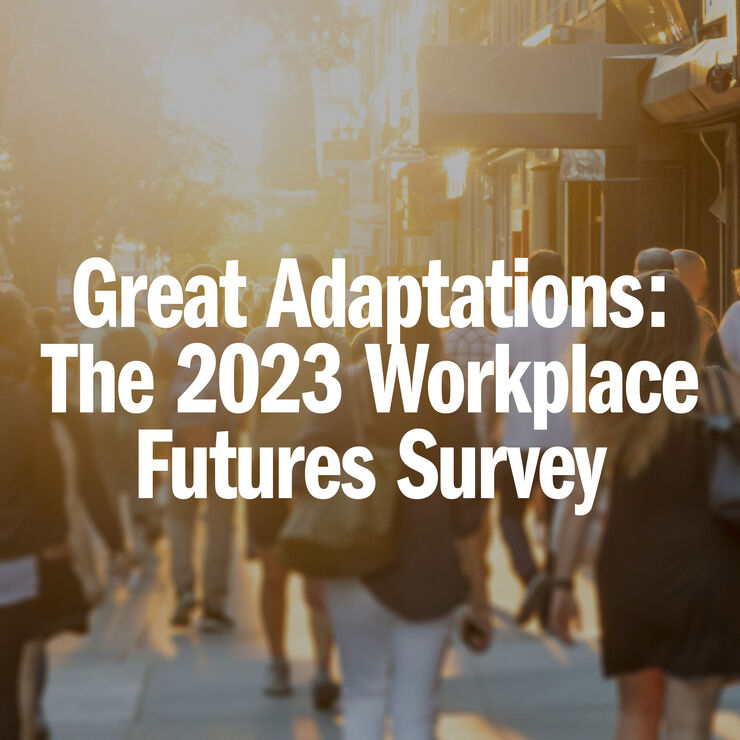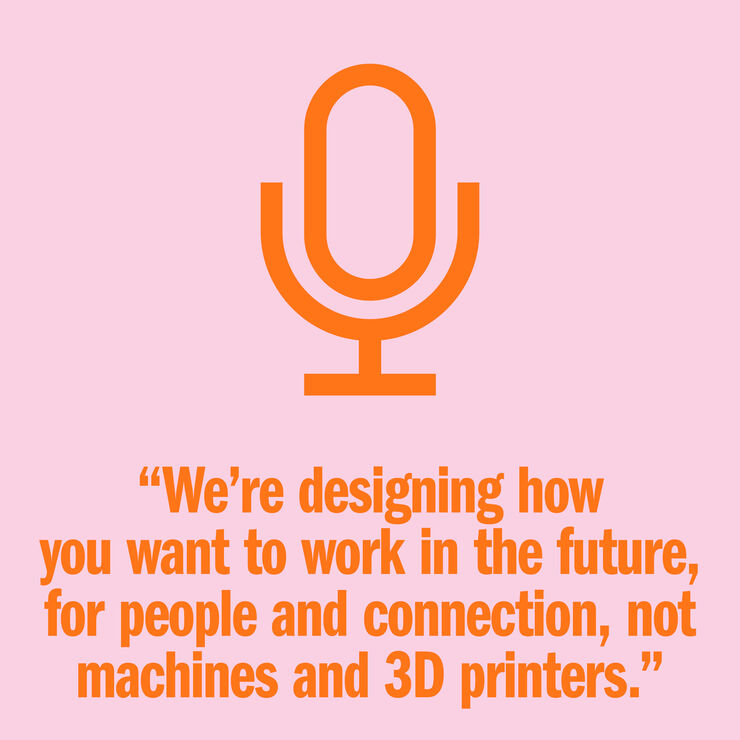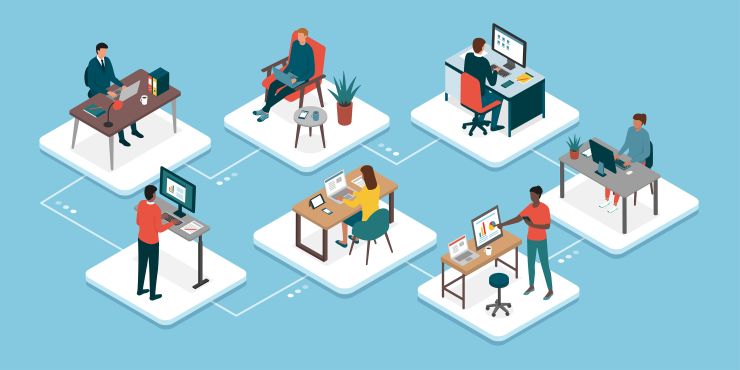Transcript
Ingrid Bakker:
Hi, I’m Ingrid Bakker and this is Hassell Talks. Welcome back. If you’re a long-time listener, you’ll be familiar with Hassell’s Annual Workplace Future Survey. It’s a survey that investigates the changes organisations are making, their impact, and where they might be headed next. Hassell first ran it in 2020 and every year since then, we have taken the pulse of the workplace with the number of office workers involved in the survey and locations growing each year.
So far, our four surveys have quizzed over 9,000 office workers and created over 1.8 million data points, data points that have informed, shaped, and guided workplaces, designers, and the experience of people around the world. Office workers in Australia, Singapore, the UK, and US have been part of the study from 2020. And in 2022, we were able to include mainland China with Belgium, the Netherlands, and Hong Kong added in 2023. This year’s survey, Great Adaptations, is the largest survey we’ve run to date with over 3,500 people surveyed this year. Its title reflects the adjustments workplaces are making and adaptations organisations are making around new work patterns. With me today is survey author, senior researcher Daniel Davis. Hi, Daniel.
Daniel Davis:
Hey.
Ingrid Bakker:
Daniel, we’ve been doing the survey for four years now. It was first run in the thick of COVID. Before we talk about some of the results, what is really standing out to you now? What feels different?
Daniel Davis:
I think what’s really different this year is that it’s really in a moment of transition that in the previous years of the survey, people are in the thick of it, they’re making changes on the fly. It was very just in the moment and I think what you’re seeing now is that organisations are starting to take a breath a little bit, look further ahead, and they’re starting to make lasting changes to the organisation. I think at the same time, you’re also seeing that work itself has changed really dramatically but the office hasn’t always kept up with those changes. And so, you’re seeing this disconnect at the moment between maybe what people’s experience of work is and what the workplace that they’re going back to, how that is structured.
Ingrid Bakker:
Yeah. Super interesting. And how much universal alignment are you seeing between markets after years of big differences?
Daniel Davis:
Yeah. So in the previous years, there are always a lot of variations and that was driven largely by what was happening in each of their countries and which countries were in the middle of the pandemic, which ones were locking down, which ones were opening back up. This year, there’s still a lot of diversity. We have a really diverse sample. China is very different from the United States, it’s very different from Australia, Singapore so there’s a lot of variation in the countries. But I think one thing that really comes through in all of that is that we’re seeing this convergence in terms of flexibility. That’s a pretty universal trait in all of these different countries and we’re also seeing some similarities in the amenities that people are wanting in the workplaces and the surrounding areas. We’re also seeing some changes, I think, in the number of people that are returning back to work pretty much increase in all the markets that we’re studying at the moment.
Ingrid Bakker:
And your results look at the big global trends but also break it down into those markets, don’t they? Which is particularly interesting for our clients in so many parts of the world.
Daniel Davis:
Yeah. So we have this big data set, it looks at things globally but we also break it down by demographic factors like people’s ages, industries, and the countries that they’re in. So we can look at all these subgroupings of what’s happening around the world.
Ingrid Bakker:
Yeah. Fantastic. Okay, let’s jump into some of these insights.
Daniel Davis:
There were five things that we found in the survey and today, we’ll just focus on three of them. The first one was that people are returning to the office but that they’re returning pretty slowly. So across all the markets that we study, the number of people in the office is increasing and the number of people that are working at home is decreasing.
And there’s a number of different reasons for this. Obviously, the lockdowns have ended in all the places that we’re studying so that makes a big difference. You’re seeing more organisations requiring employees to work from the office or encouraging them to work from the office. We’re also seeing, I think, pretty interestingly for the people that can choose where to work, more of those people that have the choice of where they work, deciding to spend more time in the office and that’s something that we haven’t seen in the previous years of the survey.
Ingrid Bakker:
Yeah. I think that’s the really interesting thing. From my perspective, that’s great news that people are coming back into the office. There seems to be an upward trend which is great. But definitely, hybrid is here to stay so I think we all need to really embrace that and make sure we understand how to make that work within our workplaces. But as you were saying, there seems to be quite a strong correlation between people’s want to return to their workplaces and their organization’s flexible working policies. Can you talk a little bit more about that?
Daniel Davis:
The people in the survey, they have a range of different workplace policies. The ones that I think tend to be doing the best tend to have a flexible policy. So people want some autonomy over where they work. They want to be able to choose a place that works best for them. And increasingly, those people that have a choice are choosing the office but the only times that they’re doing that is really when the office working for them. So there’s offices that have good collaboration space, good space to do focused productive work, and good technology. It’s three things that are really key to that experience. And it sounds really basic, but many workplaces don’t get that right. And so, when those ingredients are in place, you’re seeing more people choosing to be back into the office.
Ingrid Bakker:
Yeah. Great. And I know a lot of our clients are really focused on the precinct or the development, not just within the actual office workplace but all of the amenity around people’s office and what’s happening in the precinct. How important was that in the findings around people, what they want when they come to work?
Daniel Davis:
Yes. We had a question this year or a couple of questions this year in the survey asking people what they were doing before and after they came to work and then also what amenities they wanted around their building. And I think there’s two things that really stood out to me from that. One is that when people are coming into an office, they’re not just going there to work, they’re often linking that trip in with other things that they want to do or have to do.
So they might be visiting a grocery store, they might be going to a bar, they might be going to a gym, and so they’re making that commute into the office worthwhile by linking it with trips they would’ve otherwise made anyway. The other thing that we saw in that data was that the amenities that people want, particularly around office buildings, are pretty universal actually in all the markets that we studied. Grocery stores came out on top and then retail and cafes and coffee is up there as well.
Ingrid Bakker:
Yeah. I’m super interested about the grocery store because I noticed that was quite really at the top of every country’s list almost, apart from a couple. And I think that’s quite different to what we’ve seen in the previous surveys. So why do you think that’s really risen to the top this year?
Daniel Davis:
Yeah. So obviously, there’s a lot of concern at the moment around things like the cost of living, inflation, and I think you’re seeing that in the way that some people are prioritising or making decisions at the moment. So I think for the grocery store, part of its appeal is that you can go there and pick up a cheap lunch and go back to the office. I think also part of it is that you can pick up something fresh and head back home at the end of the day. So I think there’s something there about the cost of living that makes the grocery store an appealing amenity at the moment.
Ingrid Bakker:
Yeah. That makes sense. I’ve been talking to a lot of our clients and particularly the tenants are saying, “What’s the one thing we can do that’s going to bring people back?” or, “What’s the one thing we can do that’s going to make our workplace amazing?” Does the data give us that kind of insight?
Daniel Davis:
Yeah. So we really hope that we would get that kind of insight in the survey this year and we asked a lot of questions about changes that organisations were making to the workplaces in terms of were they adding phone booths in? Were they adding perks in? Were they adding more wellness spaces? Whatever it was. And we wanted to look at that and see whether that correlated with higher rates of return or more satisfaction with employees.
When we really dug into the data, the thing that stood out was how much the changes depended on the nature of the organisation. So it wasn’t one universal change that every organisation could make that would suddenly make the workplace attractive to their employees. It really depended a lot on the size of the company, the management style and philosophy, the location of their company globally, the industry that the company was in, and some of the cultural factors around that. And when you look at those factors altogether, you begin to get a sense of which changes make sense for a particular organisation but it’s really not a one size fits all magic bullet available right now.
Ingrid Bakker:
Yeah. And I think that makes sense given that every organisation is different anyway. Given this was the first time that everyone we surveyed was out of lockdown. All of the previous surveys, someone was going into lockdown or coming out of lockdown, it skewed the data probably a little bit but this was the first year everyone was out of lockdown. Was there anything that surprised you in the data?
Daniel Davis:
So the thing that surprised me was you’re never too sure when you run these surveys where things are going to end up and I think particularly with the end of the lockdown, you weren’t sure how hard things were going to bounce back in different regions. I think probably the thing that surprised me the most was just seeing how China was… How strong the return to office there was. When I talked to people there, it’s almost like things are close to being back to normal there, which definitely isn’t the experience of people in places like the UK or Europe or America. So just seeing that strength of the return there really stood out to me, I think, as being an outlier in terms of that.
Ingrid Bakker:
So Daniel, this is the fourth survey that we’ve run. We’re definitely going to run another one next year. What do you think we’ll see next year in the survey? What kind of things might we expect?
Daniel Davis:
So I’m assuming, this year, we saw this gradual increase in the return to the office, I think that we’re going to continue to see that year over year for the next couple of years. I’m not expecting things to bounce back to where they were. I think you’ll still see this continual focus on hybrid work and employees wanting flexibility. I think there’s also a whole bunch of macro factors that are outside that are hard to anticipate where they’re going to go. I think how the economy goes in the next year is really going to drive a lot of this and might end up influencing a lot of what happens next year in terms of the return to work or where people are working.
Ingrid Bakker:
Yeah. Great. I look forward to next year’s. But for this year’s, where can people go to get the rest of the insights from your research?
Daniel Davis:
Probably the easiest place to get it is the Hassell website. We have a insight section there and the white paper is available there along with a blog post about it.
Ingrid Bakker:
And also, if people want us to come and present the insights, we can also do that either via Teams or in person depending on location. So we’re really open to people reaching out and if they want people within their organisation to hear about this great research, please just let us know. Well, thanks for your time today, Daniel.
Daniel Davis:
Thank you.
Ingrid Bakker:
I think it’s so fascinating. I love reading the insights as soon as they come out every year. I think a lot of our clients do as well. There’s a lot of anticipation building around what’s next so I think this is really, really valuable insights into what people really want from their workplace. And obviously, we want to thank our clients and our workplace collaborators who we have so many terrific conversations with about these insights and their observations from their organisations. That helps us to build the questions each year to really understand what is going on.
I’m Ingrid Bakker. I co-lead the workplace and commercial sector and if you want to know more about this great research, as I said earlier, please reach out. Either send us an email to insight@hassellstudio.com and we’d be really happy to continue the conversation with you.
This episode was produced by Prue Vincent.



